Japy Freres antique bell-striking carriage clock c. 1860 fully overhauled

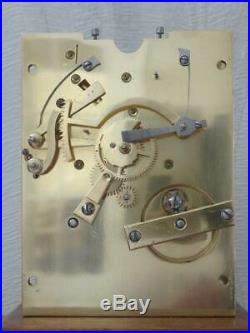

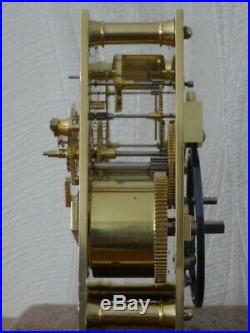
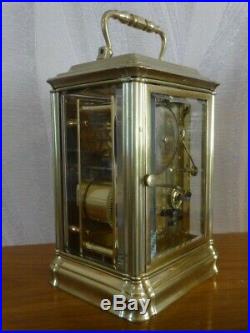

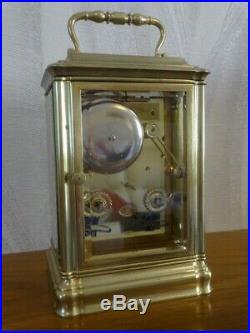
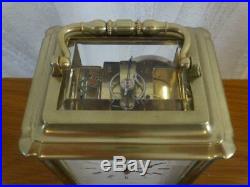
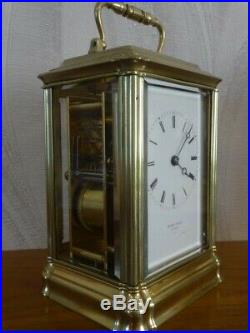

This is an antique (circa 1860), bell-striking French carriage clock by the renowned clockmaker Japy Fr. It was retailed by Henry Marc see the dial plate and the stamp in the bottom of the back plate, along with Marcs serial number of 29922. Please look carefully at the description and pictures, as they all form an integral part of this sale. The company founder was Fr.
His company was based in Badevel and initially produced basic watch movements. The company grew to become the most singularly important watch/clockmaking organization in France, with offices in Badevel, Beaucourt and Paris. He was particularly important in the development of hour and quarter repeater carriage clocks as well as calendar works etc.
Possibly the greatest accolade he was paid was winning the Gold Medal of Honour in the 1855 exhibition. His company grew to be diverse, even to the extent that the first petrol engine to be in a Peugeot vehicle was made by Japy!When acquired, the clock had obviously been put aside for many years and was in quite a neglected state. Despite its condition, after restoration, it has come back to life and in good condition throughout. Its height with handle raised of 6. Inches makes it - later referred to - a Calibre N.
2 - the middle of the three so-called full-sized carriage clocks. The face is of the classic white enamel-on-copper construction.The Roman numerals are in excellent condition, as is the chapter ring and the delicate blued-steel Breguet (or moon) style hands. Overall, the case is in very good condition. It takes the form of a gorge case. However, the handle is not typical gorge as it has the three parts to the handle.
But, all the components are gorge-shaped. Assembling the case is akin to the standard Corniche case and the escapement platform is rectangular and large. There are also a few minor marks on the case, but nothing other than one should expect from such an aged clock, being somewhere around 160 years old. The clock comes with a 3.5mm correctly fitting double-ended key. The movement strikes once on the half-hour and the number of hours on the hour on a polished chromed bell.
Including base platform 9.4 cms. Including base platform 8.3 cms. Including base platform 13.1 cms. And with handle raised 16.3 cms. Outside of the back plate bottom left. Front of the front plate bottom right. The movement (less platform) was initially soaked in petrol to loosen all the old dried grease and oil. It was then dried and carefully dismantled to component level. The following procedures were carried out.All components cleaned ultrasonically in a horological cleansing solution; washed, rinsed and heater dried. Wheels, arbors, leaves, levers, springs, rack, snail, pinions and pivots all checked for alignment and wear none found.
Pivots polished on clockmakers lathe. Movement plates examined and pivot holes/bearings checked for wear (possible distortion, usually due to mechanical pressure, lack of servicing, or simply age-related wear) - none found. Pivot holes pegged out to remove all remaining debris (a paste of old/dried oil).
The mainspring (the clocks muscle) and strike barrels were dismantled, their springs removed and checked for wear (none found). Both springs are in excellent condition. With the mainspring having a working Geneva stop-work see. The springs were cleaned, lightly greased and re-fitted into their respective barrels. All components de-greased in isopropyl alcohol and then brush-polished with French chalk, which also helps to delay tarnishing, a natural brass occurrence.
Movement re-assembled - all arbors checked for end shake. Contrate cock adjusted for correct depthing between the contrate wheel and escape pinion. All sinks oiled with high-grade Moebius clock oil.Stop works - were generally fitted to the higher quality carriage clocks. This device stops the mainspring from being fully wound and becoming fully unwound. Springs deliver maximum power when wound and gradually lose power towards the end of the run-down. The stop work ensures that the power delivered to the going train by the mainspring is quite constant therefore aiding timekeeping. Naturally, it also stops the mainspring from being over-wound.
As this clock has a working stop work, it does need to be wound every seven days. It manages the power generated by the mainspring through the going train controlling the clocks timekeeping ad is also the most delicate assembly. This is a simple and good brass platform with an off-set club-toothed ratchet lever, individual cocks and timing screws on a steel balance wheel (typical of Japy) and in perfect working order. Platform dismantled and all components (other than the hairspring), were cleaned in a 4-stage automatic watch component cleaning machine. The hairspring was cleaned in an oil-based cleaner. No rust was present anywhere on the spring, which unusually, is wound in the opposite direction to the norm. Platform polished with French chalk. Jewels checked for wear - pegged out and cleaned as appropriate. Balance wheel, impulse jewel, fork and pallets cleaned; staff, pivots and all jewels checked for wear.Escape wheel, pinion, leaves and index all cleaned and checked for wear. Components de-greased in isopropyl alcohol.
Platform reassembled, oiled with high grade watch oil, powered, timed to 18,000 beats/hr. And beat-adjusted using a purpose-made timing device. Once adjusted and timed, the platform now produces an even beat, a positive action with good amplitude and the hairspring breathing correctly within the index. Like the rest of this clock, it is now in pristine condition. The faceplate, dial and hands.
Are all in excellent condition, with the classic white enamel-on-copper face, Roman numerals and chapter ring, having no cracks, hairlines or missing enamel. The Roman numerals and chapter ring are very delicately inked typical of the period and in excellent condition, as are the delicate blued steel Breguet (or moon) hands. The movement, dial, false plate and hands were re-assembled and powered while the case was being overhauled. It has the form of the gorge case, but is not gorge for three reasons. The handle is not the classic five ripple gorge handle, but is the three bail type.
There are two separate channeled frames top and bottom - in which the glass panels sit. The way in which the columns are screwed to the case are not gorge, but more Corniche. The case was dismantled to component level and the following procedures carried out.
Parts soaked for 24 hours in a warm solution of horological cleanser, washed, rinsed and heater dried. All case components were then cleaned with a metal burnishing paste used by museums. They were then dipped in isopropyl alcohol for de-greasing. Other than the front glass which has a small mark which cannot be polished out, all the bevelled glass panels and platform viewing window are in excellent condition. They do not rattle when in situ - due to their perfect fit.
As the case has been cleaned, lacquered and waxed, it will need no further attention other than dusting. Microfibre cloths are excellent for this. Under no circumstances should any silicon-based or metal polishes come anywhere near the clock. Was carried out once the movement was reinstalled into its case and powered.
It has now been run for four full rundowns without any issues, keeping excellent time throughout. The indexs regulator arm is close to the centre of its operational arc, which is where it should be after a complete overhaul and regulation. This is an express condition of an export sale.
This is a good quality bell-striking, brass-cased carriage clock, made by the respected clockmaker Japy Fr. Following a complete and sensitive overhaul has brought it back to being in good condition, both visually and operationally.It should be serviced every five years by a competent clockmaker to ensure optimum performance, as this is the working life of good quality clock/watch oil. Should you have any additional questions, please do not hesitate to ask - I will be happy to help.
A user guide is supplied as is the signed restoration report. The item "Japy Freres antique bell-striking carriage clock c.
1860 fully overhauled" is in sale since Saturday, July 4, 2020. This item is in the category "Antiques\Antique Clocks\Mantel/Carriage Clocks\Pre-1900". The seller is "crahanfarm" and is located in Westbury.
This item can be shipped worldwide.
- Age: Circa 1860
- Material: Brass
- Type: Mantel/ Carriage Clock
- Features: Bell striker
- Sub-Type: Carriage Clock
- Clock Type: Mantel/ Carriage Clock
- Style/ Origin/ Theme: French
